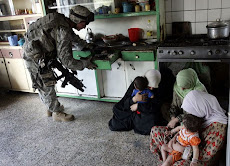
 NEW DELHI, Aug. 7 — As exceptionally heavy rains continued to cut a wide swath of ruin across northern India, a top UN official warned Tuesday that the vagaries of climate change could destroy vast swaths of farmland in this country, ultimately affecting food production and adding to the woes of already desperate peasants who live off of the land.
NEW DELHI, Aug. 7 — As exceptionally heavy rains continued to cut a wide swath of ruin across northern India, a top UN official warned Tuesday that the vagaries of climate change could destroy vast swaths of farmland in this country, ultimately affecting food production and adding to the woes of already desperate peasants who live off of the land.A villager in Bogiajan, Assam State, which has been hit hard by flooding, wading past submerged houses to get drinking water. Even a small increase in temperatures, said Jacques Diouf, director general of the United Nations Food and Agricultural Organization, could push down crop yields in southern regions of the world, even as agricultural productivity goes up in northern climes like Europe. A greater frequency of droughts and floods, the agency added, could be particularly bad for agriculture. “Rain-fed agriculture in marginal areas in semiarid and subhumid regions is mostly at risk,” Mr. Diouf said on a visit to the southern Indian city of Chennai. “India could lose 125 million tons of its rain-fed cereal production, equivalent to 18 percent of its total production.”
That is a signal of the steep human and economic impact of extreme weather in India, where a majority of peasants still rely on the rains to irrigate their fields and where a bad flood can be nearly as devastating as a bad drought. The latest floods have affected an estimated 20 million people in India alone, 8 million in neighboring Bangladesh and 300,000 in Nepal, according to the United Nations children’s agency. The World Meteorological Organization said in a statement on Tuesday that the region experienced double the normal number of monsoon depressions in the first half of the four-month rainy season that started in June, causing heavy rainfall and flooding across South Asia.
Nearly a third of India’s meteorological districts received higher-than-average rains, according to government figures. The latest tally released by the Home Ministry reads like an inventory of ruin: nearly 8,000 square miles of agricultural land inundated since the start of the monsoon two months ago, more than 130,000 houses destroyed, 1,428 people killed. Government relief teams have fanned out across northern Assam, Bihar and Uttar Pradesh States, dropping relief packets by air. Even as the rains stopped over the last couple of days, stagnant water raised the risks of water-borne disease, from diarrhea to dengue fever, in areas that are already among the nation’s poorest and least healthy. There have been no reports of disease outbreaks yet. India stands to bear the brunt of some of the worst effects of climate change, in large measure because it is ill-prepared. When the rivers swell, fragile embankments burst. Mud and thatch houses easily crumble. When the water rises, as it does year after year to varying degrees, Indian peasants are ritually stranded. “These floods are a curse to us,” Ganesh Acharya, 40, said by telephone from a marooned part of Bihar State. “Our lives comes to a standstill.” In his village, he said, the rice crop had washed away, and people have had to paddle to a nearby village to buy basic goods, at far higher prices than normal. Shiv Shankar Acharya, 58, a local college lecturer, said he did not recall when so much water had accumulated, and had refused to subside for more than 10 days.
+++++++++++++++++++++++++++++++++++++++++++++++++++
Disclaimer
No responsibility or liability shall attach itself to either myself or to the blogspot ‘Mozlink’ for any or all of the articles/images placed here. The placing of an article does not necessarily imply that I agree or accept the contents of the article as being necessarily factual in theology, dogma or otherwise.
Mozlink








































No comments:
Post a Comment